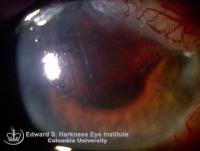Suprachoroidal and Vitreous Hemorrhage Post ECCE
- One of the most devastated complication of ocular surgeries
- May occur during any form of intraocular surgery or in eyes with a recent history of ocular surgeries such as cataract extraction, glaucoma surgeries, vitreoretinal surgeries and penetrating keratoplasty
- It may be minimal and limited to one or two quadrant, but can be massive enough to cause expulsive hemorrhage with protrusion of intraocular contents and retinal surfaces apposition
- Risk factors:
- General: advanced age, high myopia, cardiovascular disease, diabetes, chronic hypertension, atherosclerosis
- Intraoperative: ocular pain, hypertension, cough reflex, vitreous loss
Clinical Features
- Symptoms: severe ocular pain and loss of vision
- Signs:
- Dark choroidal mass with or without vitreous hemorrhage
- Shallowing of the anterior chamber
- Hypotony during or after intraocular surgery
- Firmness of the globe
- Bleeding through the surgical wound
Management
- Immediate closure of the globe once intraoperative hemorrhage occurs
- Anterior chamber reformed with viscoelastic material
- Surgical drainage of the blood
- Surgical evacuation of the blood clot after it has been liquefied as determined by serial B-scan ultrasonography
- Visual outcome can be excellent with prompt and proper management
